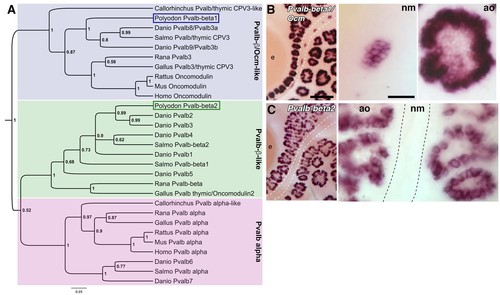Fig. 5
- ID
- ZDB-FIG-170606-21
- Publication
- Modrell et al., 2017 - Insights into electrosensory organ development, physiology and evolution from a lateral line-enriched transcriptome
- Other Figures
- All Figure Page
- Back to All Figure Page
|
Two beta-parvalbumin genes are differentially expressed in ampullary organs versus neuromasts. (A) Phylogenetic analysis of selected vertebrate parvalbumin proteins shows three clades: the alpha-parvalbumins, plus two clades containing beta-parvalbumins: the first includes the mammalian beta-parvalbumins, i.e., oncomodulins, and chicken Pvalb3/thymic CPV3. One of the paddlefish lateral line-enriched parvalbumin genes encodes a protein that groups within the beta-parvalbumin clade containing the oncomodulins, so we have named it Pvalbβ1/Ocm. The other falls within the second beta-parvalbumin clade, so we have named it Pvalbβ2. (B) In situ hybridization shows that Pvalbβ1/Ocm is expressed in both ampullary organs and neuromasts, while (C) Pvalbβ2 is restricted to ampullary organs. Scale bars: 100 µm and 20 µm. |

